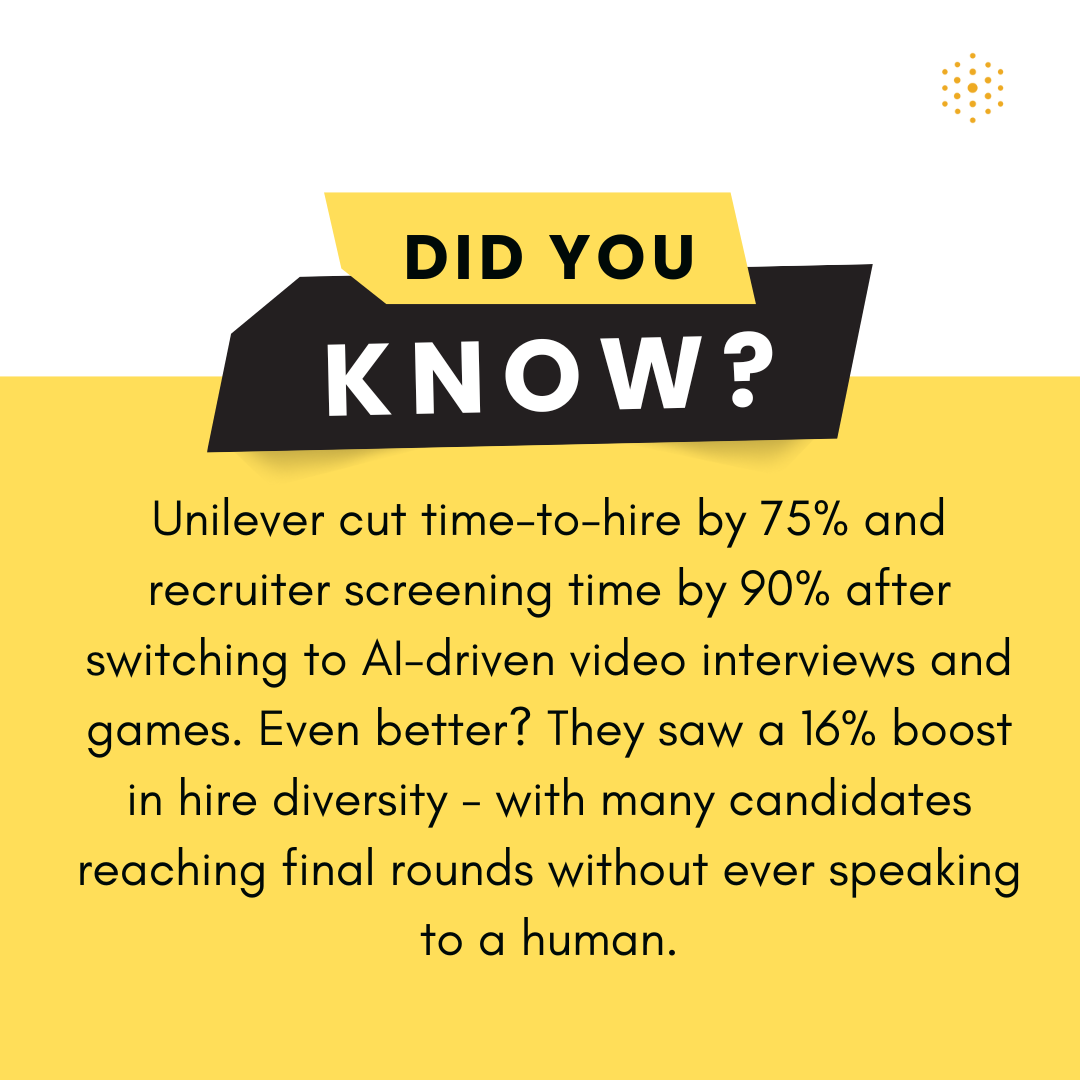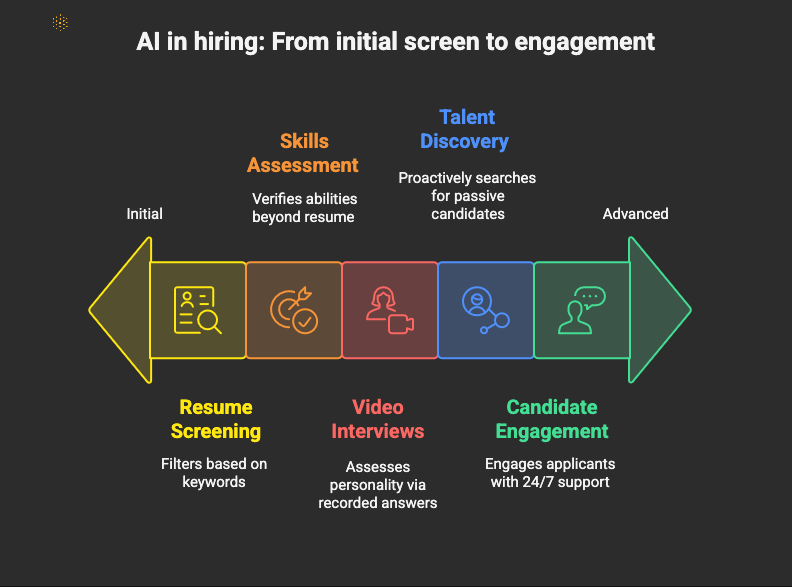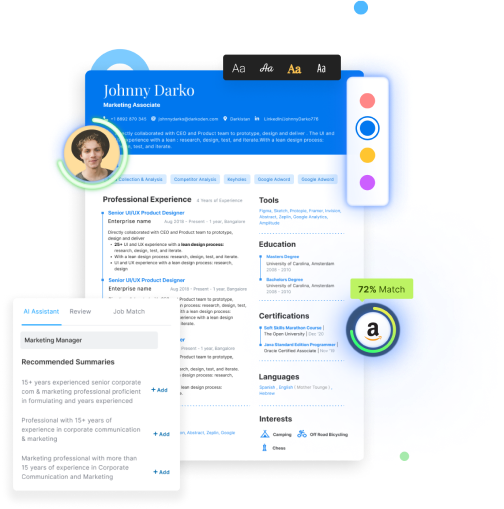How should job seekers adapt to AI-driven recruitment?
Tailor for ATS by mirroring keywords, using standard sections and clean formatting; prove skills with a portfolio. Prepare concise answers for one-way video, keep LinkedIn updated to be found, and use chatbots for role details and pre-screen responses.
40% of companies now use AI to source and engage talent, while 28% analyze recruitment data and another 28% use it to craft social posts.
But these numbers only scratch the surface.
Behind them is a deeper reality: from the moment you submit your resume to your final interview, there’s a good chance an algorithm is watching.
And this shift isn’t just transforming how companies hire, it’s redefining how you need to position yourself as a candidate.
Here are 5 key ways companies are using AI in hiring today, and how you can stay ahead at every step.
1. AI for Automated Resume Screening
How it's used: This is the most common use of AI in hiring. Companies use Applicant Tracking Systems (ATS) to automatically scan, sort, and rank job applications.
The AI looks for specific keywords and qualifications that match the job description, filtering out resumes that don't appear to be a good fit. For instance, a global company like Unilever was an early adopter of this technology,
How you can adapt
- Mirror Keywords: Carefully read the job description and identify key skills and qualifications. Use these exact resume keywords and phrases naturally in your resume.
- Keep Formatting Simple: Use a clean, standard resume format. Avoid columns, tables, images, and fancy fonts, as these can confuse the ATS.
- Use Standard Headings: Stick to conventional resume sections like “Work Experience,” “Education,” and “Skills.”
- Check Your Work: Before you apply, use an online resume scanner to compare your resume against the job description. This will give you a match score and suggestions for improvement.

2. AI for Pre-employment Skills Assessment
How it's used: To go beyond the resume, companies use AI to verify a candidate's abilities.
In fact, a 2024 CareerBuilder study found that organizations using AI-driven pre-hire assessments are 46% more likely to find successful hires.
Financial giants like Goldman Sachs use these tools, including coding challenges and situational judgment tests, to vet the hundreds of thousands of applications they receive for competitive programs.
How you can adapt
- Show, Don't Just Tell: Don't just list a skill, prove it. Link to your online portfolio, GitHub repository, or relevant work directly in your application to showcase your technical skills.
- Take Assessments Seriously: If you receive an assessment link, set aside quiet, uninterrupted time to complete it. Read the instructions carefully. For gamified tests, remember they are often measuring how you approach a problem, not just the final answer.
- Practice: Many platforms offer practice tests. Use them to get comfortable with the format and type of questions you'll face.
3. AI for Asynchronous Video Interviews
How it's used: In an asynchronous (or one-way) video interview, you don't speak to a live person.
Instead, you record your answers to pre-set questions. This practice is becoming standard, with projections from Hirevire showing that 70% of companies will use video screening by the end of 2025.
Global brands like Hilton uses this technology to streamline its high-volume recruitment, allowing them to assess candidates for personality and service orientation across different time zones efficiently.
How you can adapt
- Prepare Talking Points: Even though it's not live, prepare with common interview questions and use the STAR method to structure your answers.
- Set Up a Professional Shot: Ensure you are in a quiet, well-lit space with a clean, professional background.
- Look at the Camera: This simulates eye contact and is a key indicator of engagement that the AI may be programmed to look for.
- Speak Clearly and Concisely: Enunciate your words and speak at a calm, steady pace. Improving your communication skills is key here.
4. AI for Talent Sourcing and Discovery
How it's used: Recruiters now, don't just wait for applications. 40% of companies now use AI to actively search the web for "passive candidates" - skilled professionals who aren't actively job hunting.
These tools scan LinkedIn, social media, and industry forums to find people who match their ideal profile.
A tech leader like Siemens, for instance, utilizes AI to proactively source talent from various online platforms to find the best fit for specialized technical roles.
How you can adapt
- Build a Strong Online Presence: Ensure that your LinkedIn profile is optimizated. An updated profile with a strong headline and a detailed "About" section ranks higher in AI search results.
- Engage Professionally: Actively participate in your field. Sharing insightful content or commenting on industry news makes you more visible to AI sourcers.

5. AI Chatbots for Candidate Engagement
How it's used: Companies use AI chatbots on their career pages to engage with potential applicants 24/7.
These bots can answer frequently asked questions about company culture, benefits, and the application process. They can also perform initial screenings and even help schedule interviews.
For instance, L'Oréal, the global beauty company, uses a chatbot to answer candidate questions about company culture and guide them through the initial application steps, creating a better overall experience.
How you can adapt
- Use the Chatbot as a Resource: Before you apply, interact with the chatbot. Ask it questions about the role or the company. This can give you valuable information to help you tailor your resume to the specific job.
- Be Prepared for a Pre-Screen: If the chatbot starts asking you screening questions (e.g., "Do you have 3 years of experience in X?"), answer them accurately and concisely, just as you would in a formal application.
Final Thoughts
AI is no longer just a behind-the-scenes tool for recruiters - it’s a major force shaping who gets noticed and who gets hired.
The good news? If employers are using AI to find the best candidates, you can use it to become one.
With Hiration, you can tap into the same tech advantage - optimizing resumes, preparing for interviews, and building stronger LinkedIn profiles.
If AI is deciding who gets through the door, it only makes sense to have AI on your side.
Frequently Asked Questions
-
What is AI-driven resume screening and how does it work?
Companies use Applicant Tracking Systems (ATS) to automatically scan, sort, and rank applications for keywords and qualifications that match the job description. Resumes that appear misaligned get filtered out before a human review.
-
How should you format your resume to pass an ATS?
Use a clean, standard resume format and stick to conventional resume sections like Work Experience, Education, and Skills. Avoid columns, tables, images, and fancy fonts that can confuse the ATS.
-
What are AI-driven pre-employment assessments?
Employers use AI to verify abilities through coding challenges and situational judgment tests. Organizations using AI-driven pre-hire assessments are 46% more likely to find successful hires.
-
How is an asynchronous video interview different from a live interview?
You do not speak to a live person; instead, you record answers to pre-set questions. This one-way format lets employers review responses later without scheduling a real-time conversation.
-
How can you prepare for an asynchronous video interview?
Prepare talking points with common interview questions and use the STAR method to structure responses. Set up a quiet, well-lit shot, look at the camera, and speak clearly and concisely.
-
How do AI tools source candidates online?
They scan platforms like LinkedIn, social media, and industry forums to find profiles matching role requirements. 40% of companies now use AI to actively search the web for "passive candidates" - skilled professionals who aren't actively job hunting.
-
Who do AI sourcing tools target?
They target "passive candidates", meaning skilled professionals who aren't actively job hunting. AI helps recruiters find people who match an ideal profile even if they are not applying.
-
How do AI chatbots support candidates during hiring?
They answer frequently asked questions about company culture, benefits, and the application process, perform initial screenings, and help schedule interviews. Career-page chatbots offer 24/7 engagement for potential applicants.
-
How should you interact with AI chatbots on career pages?
Use the chatbot as a resource by asking about the role or company to help you tailor your resume to the specific job. If it pre-screens, answer accurately and concisely.
-
What resume mistakes can confuse an ATS?
Avoid columns, tables, images, and fancy fonts. Stick to standard headings like Work Experience, Education, and Skills to improve parsing.



